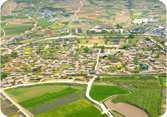World Heritage
Tentative List
- Kangjingun Kiln Sites (1994)
- Mt.Soraksan Nature Reserve (1994)
- Sites of fossilized dinosaurs throughout the Southern seacoast (2002)
- Salterns (2010)
- Southwestern Coast Tidal Flats (2010)
- Daegokcheon Stream Petroglyphs (2010)
- Ancient Mountain Fortresses in Central Korea (2010)
- Oeam Village (2011)
- Naganeupseong, Town Fortress and Village (2011)
- Upo Wetland (2011)
- Seoul City Wall (2012)
- Stone Buddhas and Pagodas at Hwasun Unjusa Temple(2017)
- Gaya Tumuli (2019)
 Naganeupseong, a historic village located in the Southwest province of Korea, is noted for its well-preserved cultural
landscape and traditional lifestyle continued from the Joseon Dynasty (1392-1910). Known as a former administrative town, stretching over Dongnae-ri, Namnae-ri and Seonae-ri in Nagan-myeon, Suncheon-si City of Jeollanam-do Province,
the folk village has preserved the crucial elements of a traditional town village, which includes a fortress, government buildings and private houses. Its traditional folklore and natural landscape add the village’s
value as an outstanding historic town of Korea.
Naganeupseong, a historic village located in the Southwest province of Korea, is noted for its well-preserved cultural
landscape and traditional lifestyle continued from the Joseon Dynasty (1392-1910). Known as a former administrative town, stretching over Dongnae-ri, Namnae-ri and Seonae-ri in Nagan-myeon, Suncheon-si City of Jeollanam-do Province,
the folk village has preserved the crucial elements of a traditional town village, which includes a fortress, government buildings and private houses. Its traditional folklore and natural landscape add the village’s
value as an outstanding historic town of Korea.
The village was created on a level field surrounded by mountains. Serving as an administrative core for Nagan-eup (county) during the Joseon and Goryeo (918-1392) Dynasties, it was equipped with necessary facilities for both public and private purposes: a government office to rule over the town; fortress for defense; a cluster of private houses; and forests forming a natural landscape and providing a space for rites. The village is also a venue for the transmission of important intangible cultural heritage, including farmer’s music (nongak), communal rituals, pansori epic chant, gayageum (12-string instrument) performance with songs (gayageum byeongchang) and seasonal customs and rites.
The records on Nagan county and its fortress can be found in several official gazettes of the Joseon Dynasty. Of them are the Annals of King Sejong (Sejong sillok), a section of the Annals of the Joseon Dynasty, the Newly Augmented Survey of the Geography of Korea (Sinjeung dongguk yeoji seungnam) and Nagan County Gazette (Nagan eupji).
According to the geography section of the Annals of King Sejong (Sejong sillok jiriji), there were 96 town fortresses (eupseong) in 334 villages. Most of them, however, were dismantled under the Japanese colonial rule from 1910 to 1945, and only a few fortresses including Naganeupseong Town Wall survive in its original condition. Amongst them the Naganeupseong is regarded the best among its kind with its well-preserved overall landscape with the fortress, government office and housings.
Administrative towns of the Joseon Dynasty are different in terms of their geographical conditions, spatial composition and visual landscape from those of the Goryeo Dynasty. Against the backdrop of a mountain, the government office was built and people’s houses settled in order. This typical spatial composition and visual aesthetics of Joseon are fully revealed in Naganeupseong, and the spatial formation and landscape differ from those of local cities in the neighboring China and Japan.
The village created inside the fortress was a venue for the local government’s ruling and people’s life since the Joseon Dynasty. A record shows that it was populated with 950 people of 337 households during the Joseon Dynasty. Afterwards, the population was reduced to 820 in 199 households, and currently 288 people live in 90 households.
The houses in the village are thatch-roofed, a fact distinguished from the other historic villages of Korea, where tile-roofed houses for the literali and thatch-roofed buildings for commoners are mixed. All private houses extant inside the fortress are thatch-roofed, following the typical type of an administrative town of Joseon, and a fortress village consisting of only thatch-roofed houses is hardly found throughout the country. Notably, the thatch-roofed houses show the typical floor plan and building arrangements──a line-shaped three-bay building facing Southwest──revealing the traditional commoners’ housing style of the Southwestern province of Korea.
The pansori epic chant, an Intangible Cultural Heritage of Humanity, has been transmitted in the fortress village, and the town is also famous for the home town of O Tae-seok, a renowned musician in playing gayageum with songs. To pray for the wellbeing of the village, communal rituals have been performed in the first month of the lunar calendar, and a communal music festivity has continued from the past.
As a typical local town of the Joseon Dynasty representative of historic fortress villages of Korea, Naganeupseong Town Wall contains the symbols of agricultural society such as thatch-roofed houses, time-honored customs and communal rites. It is comprised of essential elements for a typical administrative town of Joseon such as a cluster of people’s houses, fortress and government office. Also, the village embodies the ideological view of Confucianism, the dominant ideology of Joseon, in its spatial composition and landscape. The fortress village’s role as the administrative town of the region is also evidenced by a stele pavilion, documents and maps, folklore materials, customs and large old trees. Many families have lived in the village for generations, keeping their traditional lifestyle.



 >
>